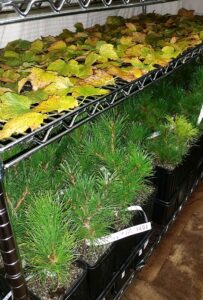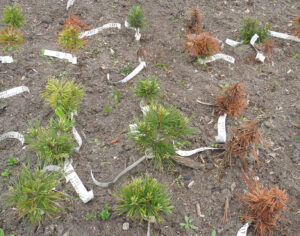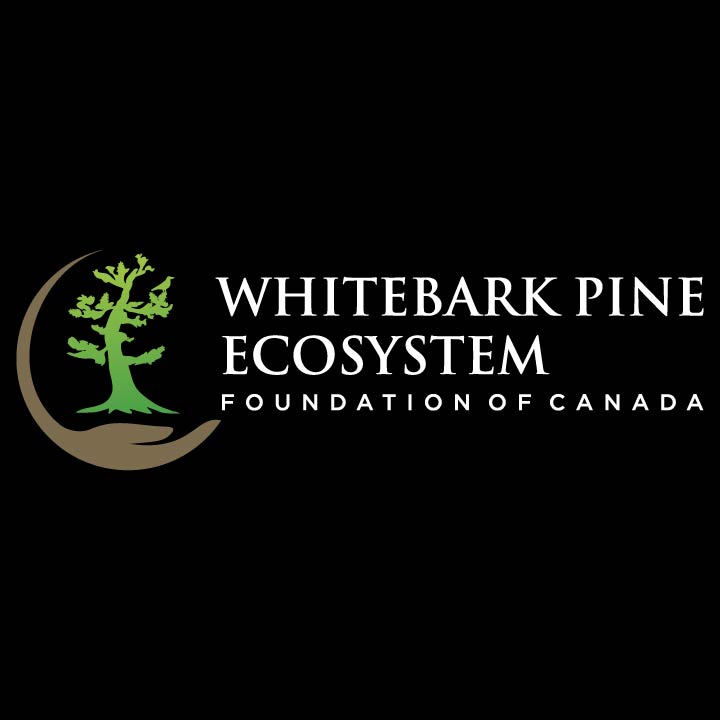Research
Resistance is Not Futile
One of the many research activities we conduct is our Inoculation Program. This is where we grow seedlings from potentially resistant trees, expose them to infection, and then monitor how the disease progresses.
The disease, called white pine blister rust, is caused by the non-native fungus (Cronartium ribicola. No fun-guy, C. ribicola has decimated whitebark and limber pine throughout most of their Canadian range. In order to protect and recover these endangered species, the identification of rare, naturally resistant parent trees is necessary. These parents will serve as seed sources for future restorative actions such as seed orchards and plantings. Our approach is patterned after the successful western white pine (P. monticola) program that resulted in its re-establishment. You can easily spy recovered western white pines from Highway 1 near Revelstoke.
How do we do it?
We obtain wind-pollinated seed from field selections in natural stands, grow seedlings for two years, then inoculate them with the basidiospores of the pathogen. Sounds simple, but there are many steps involved, and the process routinely takes 7+ years! The objective is to select individual trees from stands based on their phenotypic traits. An ideal tree would have no signs of disease with a robust crown of foliage that spans along a majority of the tree’s height. Healthy trees within heavily impacted stands are a high priority for screening.
 The inoculation stage is performed at Kalamalka Research Center in Vernon during August. The use of known highly susceptible and resistant checklots are included to establish the relative effectiveness of artificial inoculation. A dedicated inoculation room is prepared with a target temperature of 16-17° C and relative humidity equaling 100%. Seedlings are randomly arranged and placed on shelving that is cloaked with saturated sheets to reduce air movement and promote uniform spore dispersal. Leaves from the fungi’s alternate host – a currant (Ribes nigrum var “Ben”) – are placed above the seedlings and microscope slides installed to monitoring spore loads. Once spore load target is reached (3,000-5,000/cm2), the currant leaves are removed and replaced with new slides that have germination media on them. These are monitored for 48 hours while the temperature is adjusted to 20° C and humidity maintained at 100%.
The inoculation stage is performed at Kalamalka Research Center in Vernon during August. The use of known highly susceptible and resistant checklots are included to establish the relative effectiveness of artificial inoculation. A dedicated inoculation room is prepared with a target temperature of 16-17° C and relative humidity equaling 100%. Seedlings are randomly arranged and placed on shelving that is cloaked with saturated sheets to reduce air movement and promote uniform spore dispersal. Leaves from the fungi’s alternate host – a currant (Ribes nigrum var “Ben”) – are placed above the seedlings and microscope slides installed to monitoring spore loads. Once spore load target is reached (3,000-5,000/cm2), the currant leaves are removed and replaced with new slides that have germination media on them. These are monitored for 48 hours while the temperature is adjusted to 20° C and humidity maintained at 100%.
 After inoculation, seedlings are transplanted to raised beds. The following spring, individual seedlings are assessed for phenotypic responses. Needle lesions (spots) are the first trait assessed, usually within 6 — 12 months following artificial inoculation. Then, cankers are surveyed beginning about a year post-inoculation. Timing of mortality following inoculation can vary by trial and seedling family. Significant mortality typically occurs two to four years after inoculation.
After inoculation, seedlings are transplanted to raised beds. The following spring, individual seedlings are assessed for phenotypic responses. Needle lesions (spots) are the first trait assessed, usually within 6 — 12 months following artificial inoculation. Then, cankers are surveyed beginning about a year post-inoculation. Timing of mortality following inoculation can vary by trial and seedling family. Significant mortality typically occurs two to four years after inoculation.
Data collected are used to compile profiles of families and rate parent trees for levels of resistance. This information can be used to designate specific parent trees for further seed collection in restoration efforts, for scion collection and grafting of the top-ranking trees or progeny into orchards or clone banks, and to determine the contribution to that resistance of the known maternal parent. The data also provide information on the possible inheritance of the resistance types and their geographic distribution. Our overall methodology is adapted from US Forest Service protocols developed at the Dorena Genetics Resource Center in Oregon (Sniezko and others 2011).
In addition to artificial inoculations at the research center, field trials are useful for exposing families to wild inoculations and gauging long-term durability of resistance. Seedlings are planted with permanent metal tags. Seedlings are assessed for vigour, forest health agents, and mortality each year. Unlike controlled inoculations, seedlings are not assessed for number of cankers or canker severity.


